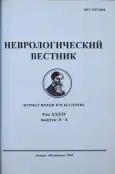Symptomatic therapy for spasticity
- Authors: Тахавиева F.V.1, Bogdanov E.I.1
-
Affiliations:
- Kazan State Medical University
- Issue: Vol XXXIV, No 3-4 (2002)
- Pages: 45-50
- Section: Review
- URL: https://journals.rcsi.science/1027-4898/article/view/89909
- DOI: https://doi.org/10.17816/nb89909
- ID: 89909
Cite item
Full Text
Abstract
Spasticity is a violation of muscle tone that occurs with central paralysis, is characterized by an increase in tonic stretch reflexes, is associated with an increase in tendon reflexes and other signs of damage to the central motor neuron [19, 22]. A large number of works are devoted to the mechanisms of its formation and clinical phenomenology in various diseases accompanied by damage to the central motor neurons [11, 19, 21, 22, 25]. It is known that spasticity is not the result of a violation of any one system - the spinal or cerebral, or one neurophysiological mechanism, but is caused by presynaptic disinhibition of GABAergic 1A terminals, a decrease in glycerinergic reciprocal inhibition, hyperexcitable depressive alpha motoneurons, 1 glycerinergic inhibition [14, 25]. Since spasticity cannot be explained by any one type of pathophysiological disorder and includes changes in both pre- and postsynaptic inhibition, it is difficult to develop an effective treatment for it. However, there are certain drugs, surgical manipulations, methods of restorative treatment, which, to one degree or another, reduce the manifestations of spasticity. Before starting such treatment, it is necessary to analyze all the facts in the clinical picture of a particular patient. First, it is necessary to decide whether the spasticity is sufficiently pronounced and whether this justifies the conduct of special therapy. Secondly, one should differentiate between true spasticity and changes in the mechanical properties of muscles. Finally, it is known that the severity of spasticity can be aggravated by various factors, both external (eg cold) and internal (eg, bladder infection or excitement) [14].
Keywords
Full Text
##article.viewOnOriginalSite##About the authors
F. V. Тахавиева
Kazan State Medical University
Author for correspondence.
Email: info@eco-vector.com
Russian Federation, Kazan
E. I. Bogdanov
Kazan State Medical University
Email: info@eco-vector.com
Russian Federation, Kazan
References
- Артемьев Д.В., Орлова О.Р., Моренкова А.Э. // Неврол. журнал. — 2000. — № 4. — Т. 5. — С. 46—51.
- Гусев Е.И., Бойко А.Н. Рассеянный склероз: от изучения иммунопатогенеза к новым методам лечения. — М., 2001.
- Гурленя А.М., Багель Г.Е. Физиотерапия и курортология нервных болезней. —Минск. 1989.
- Дамулин И.В. // Неврол. журнал — 1997. —№3. — С. 45—51.
- Демиденко Т.Д. Реабилитация при цереброваскулярной патологии. — Л., 1989.
- Кадыков А.С. // Неврол. журн. — 1997. —№9. — С.53—55.
- Albany К. // Muscle & Nerve. — 1997. — Suppl. 6. — Р. 221—231.
- Alfiery V. // Scand. J. Rehab. Med. — 1982. Vol. 14. — P. 177—182.
- Autti-Ramo J., Larsen T.A., Peltonen J. et al. // Eur. J. Neurol. — 1977. —Vol. 4. (Supp.2). — P.23—26.
- Basford J.R. Physical agents. // Rehabilitation Medicine: Principles and Practice. / Eds. J.A. DeLisa. — Philadelphia, 1993. — P.404—422.
- Benecke R. Spasticity/Spasms: Clinical aspects and treatment. // Motor Disturbanses./Ed. R. Benecke et al. — London, 1987. —P. 169—177.
- Brin M.F. / /Muscle & Nerve, 1997. Suppl. 6. — P.146—168.
- Chambers H.G. // Muscle & Nerve.,1997. — Suppl.6. — P.121—128.
- Delwaide P.J. // J. for Drug therapy and Reseach. — 1987. — Vol. 10. — № 5 — P.1—5.
- Gracies J.-M., Nanct H., Mc Guire J. et al. // Muscle & Nerve. — 1997. — Suppl.6. —P. 61—92.
- Jankovic J., Brin M.F. // Muscle & Nerve. — 1997. — Suppl. 6. — P.129—145.
- Gracies J.-M., Nance P., Elovic E. et al. // Muscle & Nerve. — Suppl. 6. — P. 92—160.
- Klimmek V., Mokrusch T. // Z. Physiother. — 1996. — Vol. 48. —P. 1008—1021.
- Lance J.W. Pyramidal and extrapyramidal disorders. / Electromyography in CNS disorders. — Boston, 1984. —P. 1—19.
- Lagalla G., Danni M., Reiter F. et al. // Am. J. Phys. Med. Rehabil. — 2000. — Vol. 79. —P. 377—384.
- Little J.W., Massagli T.L. Spasticity fnd associated abnormalities of muscle tone. / Rehabilitation Medicine: Principles and Pracnice. — Philadelphia, 1993. — P. 666—678.
- Mayer N.H. // Muscle & Nerve. — Suppl. 6. — P. 1—14.
- Simpson D.M. // Muscle & Nerve. — 1997. — Suppl. 6. — P. 169—175.
- Smyth M.D., Peacock W.J. // Muscle & Nerve. — 2000. — Suppl. 23. — P.153—163.
- Young R.R., Delwaide P. Principles and practice of restorative neurology. / Butterworth. Heinemann Ltd., 1992.
Supplementary files






